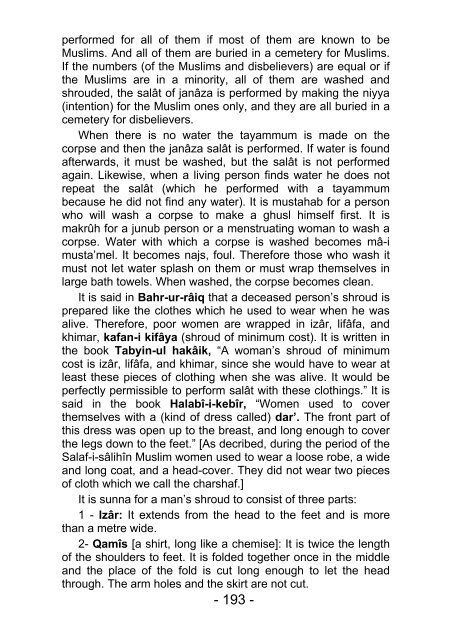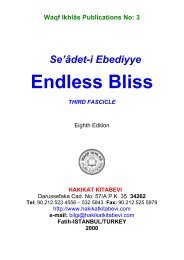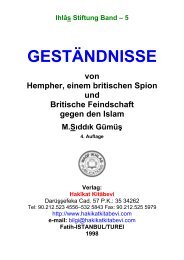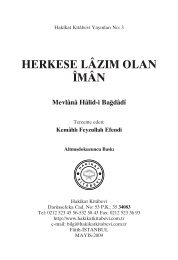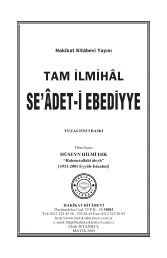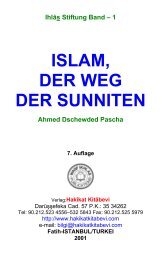5-Endless Bliss Fifth Fascicle - Hakikat Kitabevi
5-Endless Bliss Fifth Fascicle - Hakikat Kitabevi
5-Endless Bliss Fifth Fascicle - Hakikat Kitabevi
You also want an ePaper? Increase the reach of your titles
YUMPU automatically turns print PDFs into web optimized ePapers that Google loves.
performed for all of them if most of them are known to be<br />
Muslims. And all of them are buried in a cemetery for Muslims.<br />
If the numbers (of the Muslims and disbelievers) are equal or if<br />
the Muslims are in a minority, all of them are washed and<br />
shrouded, the salât of janâza is performed by making the niyya<br />
(intention) for the Muslim ones only, and they are all buried in a<br />
cemetery for disbelievers.<br />
When there is no water the tayammum is made on the<br />
corpse and then the janâza salât is performed. If water is found<br />
afterwards, it must be washed, but the salât is not performed<br />
again. Likewise, when a living person finds water he does not<br />
repeat the salât (which he performed with a tayammum<br />
because he did not find any water). It is mustahab for a person<br />
who will wash a corpse to make a ghusl himself first. It is<br />
makrûh for a junub person or a menstruating woman to wash a<br />
corpse. Water with which a corpse is washed becomes mâ-i<br />
musta’mel. It becomes najs, foul. Therefore those who wash it<br />
must not let water splash on them or must wrap themselves in<br />
large bath towels. When washed, the corpse becomes clean.<br />
It is said in Bahr-ur-râiq that a deceased person’s shroud is<br />
prepared like the clothes which he used to wear when he was<br />
alive. Therefore, poor women are wrapped in izâr, lifâfa, and<br />
khimar, kafan-i kifâya (shroud of minimum cost). It is written in<br />
the book Tabyin-ul hakâik, “A woman’s shroud of minimum<br />
cost is izâr, lifâfa, and khimar, since she would have to wear at<br />
least these pieces of clothing when she was alive. It would be<br />
perfectly permissible to perform salât with these clothings.” It is<br />
said in the book Halabî-i-kebîr, “Women used to cover<br />
themselves with a (kind of dress called) dar’. The front part of<br />
this dress was open up to the breast, and long enough to cover<br />
the legs down to the feet.” [As decribed, during the period of the<br />
Salaf-i-sâlihîn Muslim women used to wear a loose robe, a wide<br />
and long coat, and a head-cover. They did not wear two pieces<br />
of cloth which we call the charshaf.]<br />
It is sunna for a man’s shroud to consist of three parts:<br />
1 - Izâr: It extends from the head to the feet and is more<br />
than a metre wide.<br />
2- Qamîs [a shirt, long like a chemise]: It is twice the length<br />
of the shoulders to feet. It is folded together once in the middle<br />
and the place of the fold is cut long enough to let the head<br />
through. The arm holes and the skirt are not cut.<br />
- 193 -


